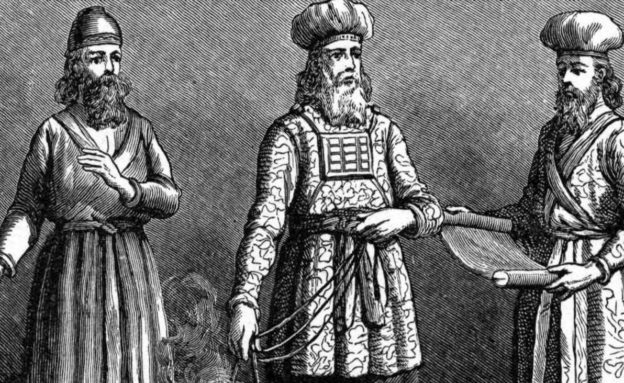People often wear clothes that are considered appropriate for their roles. Mechanics wear overalls, office workers wear professional attire, surgeons wear scrubs, and road workers wear high visibility gear. Clothed for God’s Service, the priesthood and especially the High Priest wore clothes that set them apart for their roles.
Throughout chapter 28 of Exodus, God has instructed Moses on the proper clothing fit for those serving in his house. In these final verses, further instructions are given on the clothes they wear, including a robe under the High Priest’s ephod, what covered his head, the clothes of his sons (the priests), and even the underclothes they wore! The detailed instructions remind us of the importance of our holiness in God’s presence; a holiness we only have because it has been given to us.
Along with the ephod and the breastpiece which the High Priest wore, God required a “robe of the ephod all of blue” (v.31). This robe was likely worn immediately underneath the ephod. It would have highlighted the beauty of the ephod and breastpiece, and was woven in such a way as it was pulled on over the head, reinforced to avoid tearing (v.32).
The bottom of the robe held decorations of pomegranates and bells, which would have tinkled as the High Priest went about his duties (vv.33-4). The purpose of this tinkling was to announce to God (figuratively, since God is All-Knowing) that it was the High Priest was entering the Holy Place to perform his duties, as otherwise the entrant was an intruder subject to death for entering unworthily into the Holy Place (v.35).
It also would have practically told the other priests where the High Priest was, and that he was still alive!
The next garment was a turban which the High Priest wore in his duties (vv.36-8). This turban had a gold plate on it, inscribed with “Holy to the LORD” (v.36). Aaron represented Israel in his duties; this reminded everyone of his representative role as the High Priest of a holy nation set apart by God, but also that Aaron was responsible for ensuring the intent of the sacrifices offered was to provide an acceptable sacrifice to God.
In addition, the coat (v.4) under the robe was to be made of fine linen, and a special sash was worn to highlight that the High Priest was an important position (v.39).
The priests also wore coats, sashes, and capes (v.40). They were all to wear these because they were set apart by God for ordination as priests (v.41). Amid a holy people, Aaron and his sons were singled out to serve as representatives of all God’s People in the service of God. They were to make offerings, and wait upon God in the place of his special presence with them.
For this reason, because of their privileged position of access and their representative role, even their underclothes were prescribed by God. Unlike the pagan priests whose clothing would not look that out of place in a modern music video, the priests were to be modestly dressed, in linen undergarments of a nature similar to boxer shorts (v.42).
Serving God required modesty, not flaunting their bodies. They were to be modestly and appropriately dressed whenever they served God in the Tabernacle grounds or the Holy Place. Not doing so was an offense to God, with the punishment of death (v.43).
While beautiful and elaborate, these instructions are not to provide designs for the pastor’s next outfit, but to point out the seriousness of their role. These men served God and represented God’s People before him; what they did and even what they wore was important because of where and whom they served.
The reality is that the robes did not make them holy. If anything, to the spiritually awake in their midst, it only highlighted just how far short of the standard they fell.
Years ago I preached on Zechariah 3, where the High Priest in Zechariah’s vision is made painfully aware of his sinfulness, represented by dung covered robes (making him ritually unclean, and unfit for God’s presence). But instead of being burnt up, the priest is given new, pure robes by God as a substitute for his unholy garments, making him fit for God’s presence and his service.
The same was true in Moses’ day, and true in ours too. Clothes do not make us holy before God, nor our works. God makes us holy, by clothing us in new and righteous clothes.
Those new and righteous clothes come from Jesus, who became sin for us, that we might become the righteousness of God…and wear it.
Those new robes make us fit to serve as priests in God’s presence, serving in the Temple of the Holy Spirit which is the Church, where God dwells with his People. The dapper new clothes we wear make us truly what the clothes of the priests figuratively taught: set apart servants of God, dressed up right from top to bottom, holy to the LORD.

